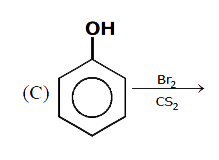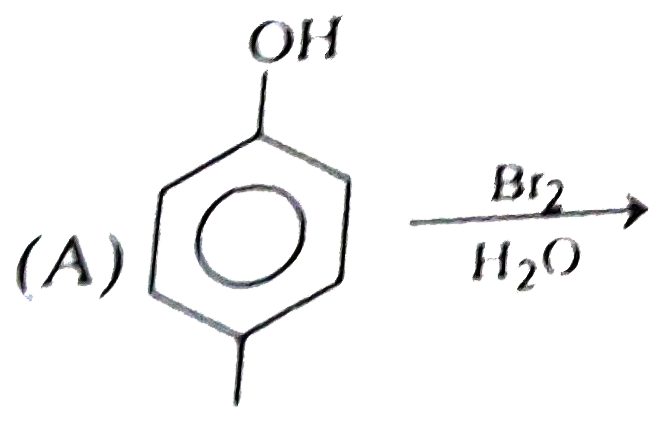Which of these compounds will not form tribromo derivative ?
Anisole
Phenol
O-cresol
Salicylic acid
The correct Answer is:C
To determine which compound will not form a tribromo derivative, we need to analyze the substituents on each compound and their effects on electrophilic aromatic substitution reactions. Let's go through the compounds step by step.
Step 1: Analyze Anisole
- Structure: Anisole has a methoxy group (OCH3) attached to a benzene ring.
- Effect: The methoxy group is a strong activating group due to its +R (resonance) effect, increasing electron density at the ortho and para positions.
- Reaction with Br2: When Br2 is added in the presence of water, anisole will undergo electrophilic aromatic substitution, resulting in the formation of a tribromo derivative at the ortho and para positions.
Step 2: Analyze Phenol
- Structure: Phenol has a hydroxyl group (OH) attached to a benzene ring.
- Effect: The hydroxyl group is also a strong activating group, increasing electron density at the ortho and para positions.
- Reaction with Br2: Similar to anisole, phenol will react with Br2 in the presence of water to form a tribromo derivative.
Step 3: Analyze Orthochrysrol
- Structure: Orthochrysrol has both a hydroxyl group (OH) and a methyl group (CH3) on the benzene ring.
- Effect: The hydroxyl group is a strong activating group, while the methyl group is a weak activating group. However, the presence of the methyl group at the ortho position will hinder the substitution at that position.
- Reaction with Br2: When Br2 is added, the reaction will lead to bromination at the para position and only one bromine at the ortho position due to steric hindrance from the methyl group. Thus, it will form a dibromo derivative, not a tribromo derivative.
Step 4: Analyze Salicylic Acid
- Structure: Salicylic acid has a hydroxyl group (OH) and a carboxylic acid group (COOH) on the benzene ring.
- Effect: The hydroxyl group is a strong activating group, and the carboxylic acid group is a deactivating group but does not hinder bromination at the ortho and para positions.
- Reaction with Br2: Salicylic acid will react with Br2 in the presence of water to yield a tribromo derivative after decarboxylation.
Conclusion
After analyzing all the compounds, we find that Orthochrysrol is the compound that will not form a tribromo derivative; it will only form a dibromo derivative due to steric hindrance from the methyl group at the ortho position.
Final Answer
The compound that will not form a tribromo derivative is Orthochrysrol.
---
- Structure: Anisole has a methoxy group (OCH3) attached to a benzene ring.
- Effect: The methoxy group is a strong activating group due to its +R (resonance) effect, increasing electron density at the ortho and para positions.
- Reaction with Br2: When Br2 is added in the presence of water, anisole will undergo electrophilic aromatic substitution, resulting in the formation of a tribromo derivative at the ortho and para positions.
- Structure: Phenol has a hydroxyl group (OH) attached to a benzene ring.
- Effect: The hydroxyl group is also a strong activating group, increasing electron density at the ortho and para positions.
- Reaction with Br2: Similar to anisole, phenol will react with Br2 in the presence of water to form a tribromo derivative.
- Structure: Orthochrysrol has both a hydroxyl group (OH) and a methyl group (CH3) on the benzene ring.
- Effect: The hydroxyl group is a strong activating group, while the methyl group is a weak activating group. However, the presence of the methyl group at the ortho position will hinder the substitution at that position.
- Reaction with Br2: When Br2 is added, the reaction will lead to bromination at the para position and only one bromine at the ortho position due to steric hindrance from the methyl group. Thus, it will form a dibromo derivative, not a tribromo derivative.
- Structure: Salicylic acid has a hydroxyl group (OH) and a carboxylic acid group (COOH) on the benzene ring.
- Effect: The hydroxyl group is a strong activating group, and the carboxylic acid group is a deactivating group but does not hinder bromination at the ortho and para positions.
- Reaction with Br2: Salicylic acid will react with Br2 in the presence of water to yield a tribromo derivative after decarboxylation.
After analyzing all the compounds, we find that Orthochrysrol is the compound that will not form a tribromo derivative; it will only form a dibromo derivative due to steric hindrance from the methyl group at the ortho position.
The compound that will not form a tribromo derivative is Orthochrysrol.
Topper's Solved these Questions
Similar Questions
Knowledge Check
Which of the following will form tri-bromo derivative of phenol ?
A B
B C
C D
D
Which of following will form tri-bromo derivative of phenol ?
A B
B C
C D
D
Which of the following compounds will not form an anhydride ?
APropandioic acidBSuccine acidCHexandioic acidDcis-But-2-en-1, 4-dioic acid
The structure of the compound that gives a tribromo derivative on treatment with bromine water is:
View SolutionThe structure of the compound that gives a tribromo derivative on treatment with bromine water is
View SolutionThe structure of the compound that gives a tribromo derivative on treatment with bromine water is:
View SolutionThe structure of the compound that gives a tribromo derivative on treatment with bromine water is :
View SolutionWhich forms new compound in air
View Solution
